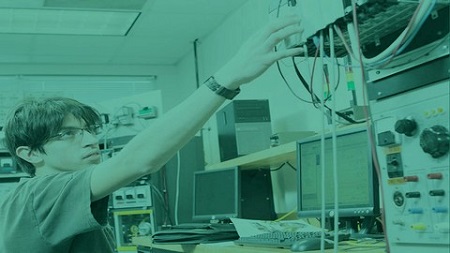English | MP4 | AVC 1280×720 | AAC 48KHz 2ch | 57 lectures (9h 51m) | 6.18 GB
Go From Zero To An Advanced Understanding Of The Fundamentals
Electronics has become important to many fields; communications, automotive, security, defense and consumer electronics, to name just a few. This course will familiarize you with the theory behind various types of electrical and electronic circuitry. It concentrates on practical aspects of the technology, rather than delving into depths of theory that will be of little value in real-world working situations.
The teaching style is conversational one-on-one, the course consisting exclusively of short video presentations. PowerPoint, screen captures, text files, and the like are not used. A PDF version of each session is provided, which you may download and combine as your own searchable resource for future reference.
If you are a person who likes to know how things work, and enjoys the challenge of figuring out why not when they don’t, the study of electrical engineering technology is sure to offer knowledge and skills that will interest you, and opportunities in the workplace that you will find personally rewarding, and financially attractive.
This course can help you qualify for careers in a variety of entry-level positions, such as electronics technician, service technician, telecommunications technician and engineering technician.
Technology-focused companies and organizations hire employees who understand analog and digital electronics. Your understanding will be complete; comparable to what you might achieve in a more formal learning environment. You will be prepared to seize opportunities that come your way in the future, and ready to go on to further, more narrowly-focused training in whatever related specialty you choose.
What you’ll learn
- When you have completed this training, your knowledge of the terminology and physical principles that form the basis of the technology will be complete, at least the equal of what you might achieve in a more formal (and expensive) learning environment. You will be ready to go on to further, more narrowly-focused training in whatever related specialty you choose, or prepared to sieze opportunities that come your way in the future.
Table of Contents
Introduction
1 Getting Acquainted
2 About Me
3 About the Course
Some Fundamental Physics
4 The Structure of Matter
5 Charge
6 Magnetism
7 A Moment for Math
The Nature of Electricity
8 Electric Current
9 Resistance
10 Power
11 Heat
Simple Resistive Circuits
12 Electronic Diagrams
13 Resistor Color Codes
14 Some Circuit Examples
15 Ground & Earth
16 Series and Shunt Connections
Capacitance and Inductance
17 DC vs. AC
18 Reactive Circuits Part 4 – RLC Circuits
19 Resonant Circuits Part 1 – Resonance
20 Resonant Circuits Part 2 – Series Resonance
21 Resonant Circuits Part 3 – Parallel Resonance
22 Alternating Current
23 Inductance
24 Transformers
25 Capacitance
26 Practical Capacitors
27 Reactive Circuits Part 1 – Triangle Measure
28 Reactive Circuits Part 2 – RL Circuits
29 Reactive Circuits Part 3 – RC Circuits
Solid State Devices
30 p-n Junctions
31 Thyristor Devices
32 Photoelectric Devices Part 1 – Photoconductive Devices
33 Photoelectric Devices Part 2 – Photovoltaic Devices
34 Diodes Part 1 – Biased PN Junctions
35 Diodes Part 2 – Scientific Notation
36 Binary Junction Transistors Part 1 – Transistor Physics
37 Binary Junction Transistors Part 2 – Simple Applications
38 Field Effect Transistors – JFETs Part 1 – JEFT Physics
39 Field Effect Transistors – JFETs Part 2 – JEFT Applications
40 Field Effect Transistors – MOSFETs Part 1 – MOSFET Physics
41 Field Effect Transistors – MOSFETs Part 2 – MOSFET Applications
Piezoelectric Devices
42 Piezoelectric Devices Part 1 – Piezoelectric Physics
43 Piezoelectric Devices Part 2 – Piezoelectric Applications
Monolithic Integrated Circuits
44 Monolithic Integrated Circuits
45 Linear Devices Part 2 – Math Operators
46 Linear Devices Part 3 – Voltage Regulators
47 Hybrid Devices Part 1 – Simple Hybrid Circuits
48 Hybrid Devices Part 2 – DA and AD Converters
49 Basic Logic Devices
50 Flip-Flops and Clocks Part 1 – Flip-Flops and Clocks
51 Flip-Flops and Clocks Part 2 – Multivibrators
52 Binary Number SystemsPart 1 – Basic Binary Numbers
53 Binary Number SystemsPart 2 – BCD and Hex Numbers
54 Digital Counters Part 1 – Ripple Counters
55 Digital Counters Part 2 – UpDown Counters
56 Linear Devices Part 1 – The Op Amp
Conclusion
57 Conclusion
Resolve the captcha to access the links!
